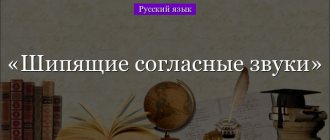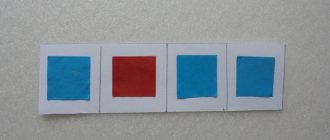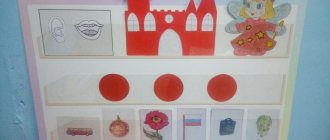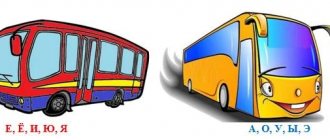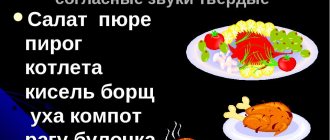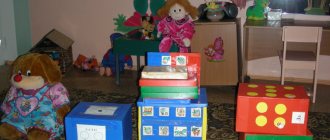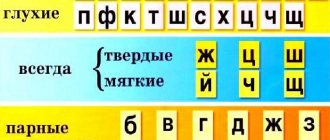Tales about sounds for children
Educational fairy tales for children
In the Land of Sounds
Lived in a magical land of sounds. This country was very tiny. And there were only 31 inhabitants. No one saw them, since they were invisible. But you could hear them. Six sounds were singers: A, U, Y, I, E, O. They were called vowels for their melodiousness and vocality. Ya, Yo, Yu, E sang along with them. The remaining 21 were also kind, with good sounds, but they could not sing. Listen: B, V, G, D, F, Z, J, K, L, M, N, P, R, S, T, F, X, C, Ch, Sh, Shch. They were very friendly, agreed with the vowels in everything, loved to stand next to them. And they were called consonants. You can also sing along with them, but to do this you need to be able to recognize all the sounds and pronounce them correctly.
“How sounds learned to turn into letters”
A lot of time has passed since sounds settled in one magical land. They were invisible, but they loved to sing. One day, a wizard from another kingdom appeared in that country. He liked it there so much that he wanted to get to know its inhabitants better. And when he found out that all the residents were invisible, he was very upset. But he was still a wizard, and a very kind one at that. And he decided to give each resident a magic dress. Each sound received a dress unlike the others. As soon as you put it on, the sound immediately became visible and turned into a letter. The letter could be seen, depicted, drawn, written. The wizard was very pleased. After all, now, having read or sung it, or whispered it, he called the sound by name. That's how they met.
Always together
One day the vowels and consonants did not get along and went in different directions. The consonants huddled together, wanted to talk - but nothing... They coughed: - Kh! They sneezed: Pchh! For some reason they called the cat: -Ks, ks, ks! And we got bored... Suddenly: -Shh! It seemed to them that someone was crying somewhere... They listened. -Ah-ah-ah! Oh-oh-oh! - shouted the vowels. They cried like little children: -Wow! Wow! Aukali: -Aw! Aw! And the consonants shouted to them (or rather, they wanted to shout, but they only managed to mumble): - BDM VSGD VMST! And they heard a joyful, but also indistinct: -U-E-E-A-E-E! They made peace, stood next to each other again, and said clearly: - WE WILL ALWAYS BE TOGETHER! And since then they have never been separated again.
Parade of letters
When two brothers b and b settled in the magical land of Alphabet Studies, there were exactly 33 inhabitants. Each had their own home, but could not exchange it for another. There were such strict laws there. One day, the Alphabet and Queen ABC decided to throw a party. All sounds put on dresses, turned into letters and went to the main square. The king gave the command to the letters to line up and take each one in its place, according to the number of the dwelling. This is the order in which the letters were: A, B, C, D, D, E, E, G, Z, I, Y, K, L, M, N, O, P, R, S, T, U, F, X, Ts, Ch, Sh, Sh, b, Y, b, E, Yu, Ya. Queen ABC really liked the structure of the letters. Since then, the structure of letters in this order began to be called by the name of the king - ALPHABET or the queen - ABC. Anyone who wants to know the secrets of this magnificent country must, like a king, know the order of the letters by heart.
Accent
One day they gathered together for council and began to say how useful and significant they all were. But they forgot to invite the words to their council STRESS. And it was very offended. When the words began to emerge, the accent suddenly jumped out and shouted: “What do you know without me?” If I want, I’ll take it and change the values for you! Of course, they didn’t believe the words. The castle came out and said: “I’m not afraid of you, I’m so strong and heavy that I can handle some kind of IMPACT.” After all, Accent is just a dash! The stress got angry and suddenly jumped from the last syllable to the first, and the castle disappeared, and a castle appeared. The words began to be indignant, to shame the Accent, but it continued to prove its importance. So instead of Atlas it turned out to be Atlas, instead of drops-drops, instead of road-road. They see words that things are bad - they cannot do without Emphasis! They gave him a place of honor at their meeting and since then they have treated the Accent with great respect.
We recommend watching:
Mathematical fairy tales for schoolchildren Psychological fairy tales for children How to read fairy tales to children correctly Old fairy tale in a new way “Turnip” (using proverbs and sayings)
Similar articles:
Fairy tales for children. Fox-sister and gray wolf
Fairy tales for primary schoolchildren. Warm bread
Ivan - peasant son and miracle Yudo
Nesmeyana the princess. Fairy tale
Marya Morevna. Fairy tale. Read
Lesson-fairy tale “The Hedgehog’s Journey” [vowels and consonants]
Depending on the age of the students, this material can be used for different purposes and at different stages of work. So, school-age children can be offered this fairy tale at the stage of familiarization with the concepts of vowel, consonant, voiceless, voiced sound . A fairy tale will help preschoolers generalize ideas on this topic, consolidate terminology, thanks to the plot, figurative comparisons and elements of comic etymology.
If desired, the lesson material can be used in parts (separately vowels and consonants).
The lesson is conducted against the background of a presentation , which includes sound and animation.
Lesson – fairy tale “Journey of the Hedgehog”
Topic: Vowels and consonants.
Goals:
- generalize children’s ideas about vowels and consonants; - consolidate the concepts: vowel, consonant, voiceless, voiced.
Equipment: cut-out alphabet, presentation, sound symbols.
1. Organizational moment
The speech therapist gives the children letters (3 pieces each: 1 vowel, 1 voiced consonant, 1 voiceless consonant) and asks:
- What is this? (Children: - These are letters)
Speech therapist: What is this? Listen: a, o, m, s, i, g? (Children: - These are sounds)
- Read your letters - name the sounds. (Children name their letters)
Speech therapist: - Find its own symbol for each letter. (Children put a red symbol under a vowel, a blue symbol with a bell under a voiced consonant, a blue symbol without a bell under a voiceless letter)
2. Announcing the topic of the lesson.
Today I will tell you a fairy tale about how a hedgehog became acquainted with sounds in his forest. You already know a lot of sounds, so you will help me.
3. Fairy tale.
(Slide 2) A hedgehog lived in one forest. He loved to walk in the forest. One day he walked for a long time and saw a red house.
(Slide 3) Someone was singing in the house. The hedgehog heard a song. (Slide 3 - sound)
- What wonderful sounds! “How they sing!” thought the hedgehog and knocked softly on the door.
The door opened and he was greeted by sound guys in red dresses. (Slide 4 with animation)
“Hello,” they said, “who are you?”
- I am an ordinary hedgehog, my name is Hedgehog, and my last name is Lesnoy. And who are you?
- And we are sounds.
- What is your name?
(By the articulation of vowels, symbolically depicted on the slide, children identify sounds. Each child must name his own sound corresponding to the letter he has. The child names the sound, shows the letter, after which this letter appears on the slide. Children’s response model: “Me name is A")
- Very nice to meet you! - said the Hedgehog.
“And we all have the same last name,” said the sounds.
-Yes? — the hedgehog was surprised, “What is your last name?”
- All of us - ….?" (Children answer “Vowels!”)
- Thank you, vowels, for the song! You sing so well! Can I come to you again?
- We will be very glad!
3. And the hedgehog moved on. Suddenly he sees a blue house standing. (Slide 5) The hedgehog stopped and began to listen. But I didn’t hear the song. But in the house, someone was growling (how? - Children determine the 1st sound in the word “growled”), hissing (how?...), buzzing (how?), snorting (how?..), puffing (how?.. ), grumbled (how?..), grumbled (how?..), wheezed (how?..), mooed (how?..), etc.
(On slide 5 there is an opportunity to demonstrate different sounds by clicking on the speaker images)
Suddenly the door opened and the hedgehog heard:
- Hello! Who are you?
- I am an ordinary hedgehog, my name is Hedgehog, and my last name is Lesnoy. And who are you?
- We are sounds.
- Oh, how many sounds there are in our forest! I won’t remember all of you right away!
- It's nothing! Remember our last names.
And immediately all the sounds scattered in different directions and formed into two columns. Only now the Hedgehog noticed that some (they stood on the left) had bells hanging around their necks, while others (they stood on the right) did not have bells.
The sounds with bells said in chorus:
- Our last name... (Children: - Voiced!)
The sounds without bells also said in chorus, but very quietly:
- Our last name... (Children: - Deaf!)
- And our name is...
And then a terrible noise arose because they all called their names together. (Children pronounce in chorus according to the consonant sound)
- All! All! Quiet! - the hedgehog shouted. But the sounds were noisy. Then the hedgehog shouted: “Quiet! I came up with something! The sounds fell silent, and then they asked in chorus:
- What?
“You need another last name so that it’s immediately clear that you all know how to make noise!” Do you agree?
- Yes! YES! - the sounds screamed. - We agree!
And so they shouted for a long, long time: “We agree! We agree! We agree! We agree! We agree! We agree!”...
“STOP!” shouted the Hedgehog. If you agree, then you CONSENT!
- Hooray!!! We agree! We agree! We agree!
- You will be VOICED CONSONANTS because you have a loud voice, and you will be DEAF CONSONANTS because you have no voice.
- What a long last name! - said one of the sounds.
- You do not like?
- Like! Like! We agree! We agree!
- Oh oh oh! - Hedgehog shouted, - How loud you are! I'll go to another house. Other sounds live there - Vowels. They sing songs, and you just make noise!
“We also want to sing, but we don’t know how,” said those who agreed sadly. Maybe you can come up with something?
- I figured it out! You need to make friends with the vowels and sing together.
- But how? We can't sing!
- And it is not necessary. You will help - pronounce your sounds, and the vowels will sing theirs. Together you get syllables and words. And syllables and words can be pronounced, sung, and even read. Let's go visit the vowels! They will be glad!
And off they went. Along the way, Hedgehog learned the names of sounds and tried to remember which of them was voiced and which was deaf.
- Do you guys remember?
(Slide 6 - with animation)
— Children classify the consonants presented on the slide, and the Speech Pathologist controls the presentation: after each answer, the Speech Pathologist clicks the mouse, and the letter is “sent” to the desired column, which allows children to check the correctness of their answers)
(Slide 7 - with sound)
Speech therapist: - Let's listen to what songs the consonant C made with vowel sounds.
... Let's learn this song.
Notes. Depending on the age of the students, this material can be used for different purposes and at different stages of work. Thus, school-age children can be offered this fairy tale at the stage of familiarization with the concepts of vowel, consonant, voiceless, voiced sound already in the first lessons.
Accordingly, the next stage may be reading words, sound-letter analysis, synthesis of syllables and words, etc.
Pyadysheva Elvira Vladislavovna, teacher-speech therapist, Education Center No. 1429, Moscow
- Speech therapy lesson summary: Vowel sounds and letters
- Presentation “Sounds and Letters”
- Presentation [Exercises for the prevention of acoustic dysgraphia - S-Sh sounds]
- Lesson summary in the first grade for a group of students with functional disabilities - Sounds [S]-[C]
- Summary of an individual speech therapy lesson: Sounds and letters R, L, automation in syllables, words
( 6 liked, average score: 4.83 out of 5)
Loading...
- Nick Bromley "Caution! This book bites!”
- Boris Zakhoder “The Whale and the Cat”
- Irina Tokmakova “Alya, Klyaksich and the letter “A””
- Georgy Yudin “Little book. The magic alphabet in pictures and fairy tales"
- Mikhail Raskatov “The Missing Letter”
- Alexander Sharov “The Adventures of Yozhenka and other drawn men”
Nick Bromley "Caution! This book bites!” Artist Nicola O'Byrne Translation from English by Maria Pak Labyrinth Press Publishing House, 2017
The books of the French artist Nicola O'Byrne are distinguished primarily by their interesting interactive component, so they are good to read with a small child. But thanks to the large print, these books are also suitable for initial independent reading. "Carefully! This book bites!”, the text of which was written by Nick Bromley, can well be considered as a fairy tale “about letters”. True, the crocodile that got into the book ate only two letters - “O” and “B”. And only on one spread the “conflict” is built around these letters. But is this not enough? It’s safe to say that the child will definitely remember “O” and “B”. And if he already knows the letters, then, quite possibly, he will be interested in finding out what a “missing letter” and “empty space” in a word mean. As a result, the word is destroyed and ceases to be a word! This, by the way, is the most important knowledge. In addition, the crocodile, as the author tells us, “swallows words and entire sentences”... A terrible creature is a crocodile. But in the meantime, the child learns about the existence of grammatical units!
Of course, both a three- and four-year-old child will most likely miss this information (although this will not relieve him of his indignation at the crocodile’s actions). But you can and should draw the attention of a child who is already starting to read to this.
Boris Zakhoder “The Whale and the Cat” Artist Evgeny Meshkov Rech Publishing House, 2017
The fairy tale “The Whale and the Cat” by Boris Zakhoder is the most “literal” fairy tale. Its plot is built around mixed up letters: “someone rearranged the letters in the fairy tale against all rules.” As a result, the whale ended up in the whale's place, and vice versa. Fun confusion ensues. This fairy tale was liked by children of past decades, parents and grandmothers of today's children. And now her humor is not outdated, and her rhymes are easily imprinted in the memory. During the carnival with cats and whales, children discover important knowledge: replacing one single letter, a small icon, completely changes the meaning of the word.
Since “whale” and “cat” are short and simple words from a graphical point of view, you can invite your child to draw them. Or you can draw pictures for a fairy tale with the “correct” whale and cat and the “wrong” ones, and then label which is which.
Irina Tokmakova “Alya, Klyaksich and the letter “A”” Artist Viktor Chizhikov Labyrinth Publishing House, 2019
Irina Tokmakova's fairy tale can be considered an ideal introduction to the world of literacy for a four- to five-year-old child (that is, from the moment when the child is already able to listen to fairy tales).
The tale is based on an exciting, dynamic plot with a detective touch (the abduction of the letter “I” by a villain, to save which you need to solve a riddle), with travel and adventure. There is a confrontation between good and bad characters, understandable to a preschooler, and a happy ending: everyone is saved, the mission of the good heroes is completed.
Most fairy tale characters are letters. But these are not letter-signs, but letters-creatures, artistic images - letters. They have their own characters and manner of speech, they perform actions. And this couldn’t be more consistent with children’s perceptions. The fact that the letters act here as “funny little people” instantly integrates them into the world of the child’s figurative dimension: they can be thought of as “alive”, you can play with them, you can make up stories.
At the same time, the fairy tale is also filled with sound writing, which is especially visual and distinguishable in the “monologues” of individual letters. The author shows the child that a letter is pronounced out loud as a certain sound and that the sounds, when combined, form a word. But this is done without a hint of didacticism; it is an organic part of the plot, which holds the child’s attention.
You can also read about this book in the articles “Letters: Adventures and Transformations” and “My Light, Mirror, Tell Me!”
Georgy Yudin “Little book. The magic alphabet in pictures and fairy tales" Illustrations by the author Publishing House "Children's Literature", 2018
Georgy Yudin's book can really replace a primer for a preschooler, since the letters here are depicted as a “cast” of some object or phenomenon, as its transformed image.
But, along with pictures, fairy tales occupy an important place in the book. The fairy tale “around the letter” and the drawn image of the letter form an inseparable unity here. The child looks at the picture, looking for a letter in it, and at this time the adult reads to him a text that uses different words starting with the corresponding sound.
You can also read about this book in the article “Turkish panties, or how to draw a hieroglyph.”
Mikhail Raskatov “The Missing Letter” Artist Evgeny Medvedev Publishing house “CompassGuide”, 2017
The plot is based on the mysterious disappearance of the letter Sh from Letter City (and from speech), and the need to find and free it. The main characters are twin first-graders, Sasha and Alyosha, whose names change in the most deplorable way with the disappearance of the letter.
The principle of constructing the plot seems to be very similar to that used by Irina Tokmakova in her fairy tale story “Alya, Klyaksich and the letter A.”
But Mikhail Raskatov’s book is much more complicated. There are many more characters here who enter into various relationships with each other. The characters of the main characters develop over the course of the story (and in Tokmakova’s fairy tale, which is addressed to children of an earlier age, the characters of the characters remain practically unchanged). Saa and Alea must overcome themselves to regain their normal names. The “restoration” of the name is associated with the restoration of order as a whole. In addition, truly scary characters appear in The Missing Letter, who are called “letter eaters.” They live in a special country, where all life is subject to strict rules, the slightest deviation from which is mercilessly punished. Letter eaters oppose the inhabitants of Bukvograd, letters and punctuation marks.
While reading the book, listeners will have to go through dangerous adventures with the heroes and take part in solving a rather complex code.
This fairy tale is good to read to children who already know the letters and are gradually beginning to master the skill of reading. For children who already have experience in perceiving fairy tales and who love “scary tales.”
You can also read about this book in the article “The Missing Letter”: a detective story for little ones.”
Alexander Sharov “The Adventures of Yozhenka and other painted men” Artist Rafail Volsky Publishing house “ID Meshcheryakova”, 2016
At the heart of Alexander Sharov's fairy tale is the confrontation between two brothers - the Good Artist and the Evil Artist. The kind Artist creates images and his kind fairy-tale world. The Evil Artist also modifies the world, but always to the detriment of the Good, trying to destroy what he has created. This is a completely new way of looking at things for a child: it turns out that creativity can be destructive.
Wanting to completely destroy his good brother, the Evil Artist creates mad letters. He creates them from drawn snakes. The main quality of the new letters is to sting and form prohibiting words. The appearance of frantic letters leads to the fact that everything around becomes “as if dead.” The callous letter H guards the captured Good Artist. The bloodthirsty, fanged, treacherous letter K leads the army sent by the Evil Wizard. But in the end, the mad letters lose their poisonous stings and turn into “kind” ones. A rather complex image through which a child discovers that being able to write, being able to manipulate letters, is not an absolute benefit.
It turns out that letters can pose a threat to everything human in the world. This is a kind of philosophy lesson for children.
If you are just thinking about getting to know the letters, then it is better to put this book aside for a later time.
Let the child first learn what letters are and what they are for, and only then - that they can be “mad.”
But in general, this is an incredibly poetic and at the same time dramatic fairy tale with an unpredictably developing plot, unexpected images and persistent tension: the heroes who did not have time to avoid one danger are already facing a new misfortune. However, by the will of the storyteller, all evil characters certainly turn into good ones. Everyone - except the main villain. He's just hiding. And this leaves a feeling of anxiety in the depths of my soul.
Since the fairy tale is built on a complex play of meanings and complex images, it is best to read it to a child no earlier than five years old. Or you can offer it for independent reading to a reader about eight years old: it won’t seem simple and uninteresting.
The material was prepared by Marina Aromshtam and Elizaveta Prudovskaya
LiveInternetLiveInternet
- What does this mean? We are alone without a permanent place of residence! — EiY were indignant.
We thought and thought, and started making things for ourselves at home, and yes, and we found three sticks.
And he made a hut with a crossbar,
And I fitted the crossbar diagonally to the two posts and was very pleased.
U and Y took two sticks each. Wu made himself a house that looked like a tree with a branch. I attached half of a small wheel to one stick, and placed the second stick nearby for reliability.
O saw the wheel, and it suited him.
E looked at the cracked rim of the wheel for a long time, then he attached a stick to it and settled down - he also had a house.
Happy sounds of joy and names for their houses were invented and they began to be called by letters.
The sound A has a house-letter A, the sound U has a house-letter U, the sound O has a house-letter O, the sound I has a house-letter I, the sound E has a house-letter E, the sound Y has a house -letter Y.
Since then, looking at the letter houses, everyone will know what sounds live in them.
Part 2
One day the vowels sit in their letter houses, singing songs in all their voices. Suddenly they hear something strange, incomprehensible:
- Y.Y.Y, Y...
They look, some sound unlike them in a green shirt is trying to explain something to them, and very briefly says:
- Y, Y, Y.
I listened and recognized him as his distant relative, who was called I-short, because he sounds abruptly, briefly, and it is not always easy to hear him.
They listened and listened, and finally understood - And the short one asks to join them in the choir.
The vowels came out, stood in a circle and began to think about how to teach I to sing briefly. Everything is fine with him: his voice is clear, soft, gentle, but the sound cannot be pulled out...
To begin with, they built him a house the same as that of his relative, the sound I, but with a canopy - for distinction.
The house of I-short was called the letter I-short. I-short was delighted and thanks everyone for the letter house:
— Y.Y.Y.
I-short settled in his letter-house, listened to the vowels sing, and tried to sing along with them:
- y... y... y...
A listened and listened, and said:
- Let's try to sing together. You start and I'll pick up
I-short agreed, and they sang:
- YA, YA, YA!
“You’re doing great,” U said thoughtfully, “but will you sing with me?” - he turned to I-short.
“I will,” he answered without hesitation.
And then everyone heard:
- YU, YU. YU.
- Oh, how good! Sing with me now! - asked O.
- Please.
- YO, YO, YO! - a new song poured out.
“Eh, I don’t want to stay on the sidelines,” E reasoned, “let’s sing together,” he suggested to I-short.
The next song sounded like this:
- YE, YE, YE!
I-short rejoices: sings with A - it turns out “YA, YA, YA”, sings with U - it turns out “YU, YU, YU”, sings with O - it turns out -YO, YO. YO”, sings with E - it turns out -YE, YE, YE.”
Only Y and Y were sad
“Nice, very sweet,” sighed I, listening to his friends singing. - I would like to sing with I-short, but if I sing, no one will hear him at all: we are relatives.
“I-short and I won’t be able to sing together either.” “He’s so tall, and I’m so short,” Y grieved.
So they sat. listened to songs, talked quietly and decided to build houses where I-short could perform concerts with the sound A, with the sound U, with the sound O, with the sound E.
We thought and thought, and made four houses.
The first house was called the letter Y, in which I-short began to sing with the sound A.
The second house was called the letter Y, in which I-short began to sing with the sound U.
The third house was called the letter E , in it I-short began to sing with the sound O.
The fourth house was called the letter E, in which I-short began to sing with the sound E.
This is how they still sing in the houses - the letters I, Yu, E, E,
And the sound I-kratky, because it agreed to sing with vowels, began to be called a consonant and added to the name: ringing, soft, the voice of I-kratky is really surprisingly ringing and surprisingly soft.
They sang the sounds a lot both at home and at concerts.
The vowel sounds always appeared in red shirts, and I-short - in green.
Looking at him, all the soft sounds began to wear green shirts, and the hard sounds decided to wear blue shirts.
This is how it has been in the Russian language since then:
• six vowel sounds are indicated by red circles;
• all other sounds are consonants;
• soft consonants are indicated by green circles,
• hard consonants are blue.
That’s the end of the fairy tale, well done to those who remember.
What is the alphabet?
Do you hear the song coming from the island? Let's listen to her. What are the residents singing about?
How interesting this is. It's time to explore the surroundings. And here is a map of the island.
This map is not easy
This is the Russian ALPHABET!
He will put the letters in their places.
And order reigns in it.
Everyone needs to know the alphabet
Study together at school!
What an amazing island! Perhaps we need to learn the entire alphabet; knowing the letters will help us develop the ability to read.
Exercise
Look at the picture above, remember or count: how many letters are in the Russian alphabet?
Answer: 33 letters.
Let's walk around the island. Here it is written how the Russian alphabet originated.
How interesting! But we need to ask residents to tell us about this story in even more detail. Someone is coming towards us, it looks like the letter A!
Now guys, listen to the story associated with the appearance of the alphabet, the oldest resident of the city, Az, will tell it to us.
The Tale of the Alphabet
Great learned men appeared on Russian soil who wanted to make our state glorious and powerful. These were the monk brothers Cyril and Methodius. They chose a noble path - to make Russian people smart, to teach everyone to read and write. And before them there was no single order of letters. Taking the Greek alphabet as a basis, the brothers did a great job.
They were able to arrange all the letters. This is how the Glagolitic alphabet appeared - the first alphabet, derived from the word “verb” - to speak.
And then they made it even simpler and called it Cyrillic. 43 letters are included in this alphabet. And each letter was highlighted and given its name. The first letters were named Az, Buki - this is how the word ABC appeared.
This alphabet has changed for several centuries. Has gone through many reforms. And now we have a completely new, but very convenient alphabet that every child should know.
Glory to the alphabet! Thank you, Cyril and Methodius, for your invaluable gift to people.
Did you know that all books used to be written by hand! They were written by monks, carefully writing each letter. Such a book took a year to write, and sometimes even longer. We would not even be able to distinguish a written book from a printed one, because it was written in compliance with all the rules of style. The creators of books were called chroniclers. They were extraordinarily talented and hardworking. The first creators of handwritten books had to show a lot of strength and patience.
But soon Ivan Fedorov became the founder of book printing. Printed books appeared. They were created for training. Later, secular books began to be published, which were purchased by noble and wealthy people. Much time has passed since then, books have become an everyday item and have become a part of our lives.
Currently, all letters have two styles: printed and capital. Capital letters of the Russian alphabet are necessary for fast writing. Block letters are used in books and other publications. At the same time, teaching expressive reading occurs with the help of printed letters.
In first grade, you will develop the ability to read and write capital letters.
This skill is very important for every person. After all, writing block letters takes a long time and is completely inconvenient. Having mastered a wonderful way of writing quickly, you will cope with rewriting any text much faster. This path is difficult and will require diligence and effort. That is why every person develops his unique handwriting.
